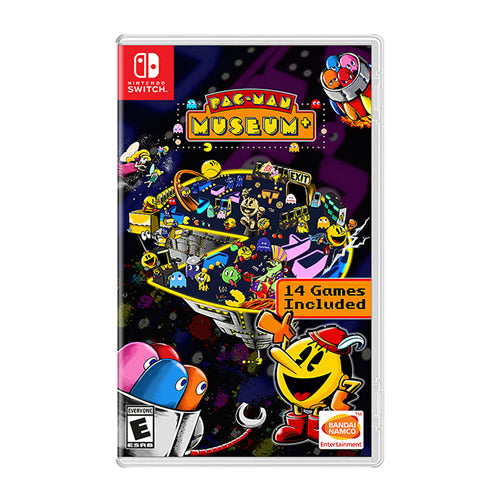Retro Tech
Nintendo Switch Pac-Man Museum+
Nintendo Switch Pac-Man Museum+
Couldn't load pickup availability
Pac-Man Museum+ follows Pac-Man Museum (2014), a collection for the Xbox 360 and PlayStation 3. This updated compilation includes some of the titles in the previous release, and adds several new ones, bringing the total count to 14 (although Pac-Man Arrangement is featured twice with arcade and home versions). It comprises the most thorough collection of the yellow, pizza-inspired dot’s exploits ever assembled, from the original arcade masterpiece, through to 2015’s Pac-Man 256.
Presented within a 3D arcade, you can move the camera, trotting Pac around, looking at various machines and deciding what to play, each game with its own menus for gameplay tutorials, special objectives, and a little history. You start with 500 virtual coins in your pocket, but there are no microtransactions here. You accrue more coins simply by playing machines and completing optional missions (presented like an achievement leaderboard) that add unique objectives for each title.
Coins are also spent on customisation of the arcade, and this aspect is rather detailed: you can buy everything from wallpaper and music for the jukebox, to new machines, plants, gashapon figures, and various other decor-related Pac-aphernalia. The longer you stay playing in your arcade, Pac-Man ghosts turn up to join you, although they spend all their time floating about rather than shooting for high scores.
As a presentational interface, it’s pretty neat, but sadly hamstrung by a really poor frame rate. Considering it’s one 3D room, and fairly basic, graphically, it seems the curse of Unity has struck again. Its choppiness seems more pronounced in handheld mode, although it’s definitely still present on the big screen, too.
If you like Pac-Man, however, you will feel very satisfied by what’s on offer. There’s a broad variety of arcade games and one ‘consumer’ machine for console titles that require no coins, its mini-library cycled with the shoulder buttons. Some titles, however, need unlocking to play. This is easily done by completing objectives, like playing a different, specified title twice, for example.
Beginning with Pac-Man (arcade, 1980) there’s little to say that hasn’t already been said. An undying classic, you frantically sweep up dots, cherries, and fend off ghosts with power pellets dotted around the grid. Scoring is the name of the game, and it’s as superb as it ever was to die trying.

Super Pac-Man (arcade, 1982) adjusts the formula by having you grab keys to open locked gates around the grid so you can collect all the fruit. It’s an enjoyable variation that fans of the original will enjoy when they want to mix things up a bit. It’s by no means as good as the original, of course, since a layer of simplicity has been lost, but fun nonetheless.
Pac & Pal (arcade, 1983) twists Super Pac-Man’s formula further, introducing power pellets with five specific uses, some based on famous Namco titles like Galaxian and Rally-X. These allow you to stun, freeze and confuse the ghosts. Flipping cards opens many of the gates, and a new helper, the green Miru — Pac-Man’s “Pal”, as it were — helps you to grab fruit but decreases your overall score in doing so. There’s some depth here, and it’s good fun to get involved in. It’s also notably the first Pac-Man title to have music playing over the action.
Pac Land (arcade, 1984) is one of the first true arcade platform games, appearing one year prior to Super Mario Bros., and it’s utterly superb. The theme tune burns itself into the brain, and graphically it holds up very well owing to its unique art style. You run Pac back and forth, jumping over obstacles and ghosts, through forests and across falling mountain logs, before powering up with flight and soaring back the way you came, all under the duress of a time limit. Complete the first course and you’re off again, now with new obstacles and increased difficulty. It’s an excellent title to have as part of the collection.

Pac-Mania (arcade, 1987) slows things down and goes graphically isometric, using the same maze, dot-eating formula, with the added bonus of being able to leap ghosts in a single bound. It’s visually superb, comparatively leisurely, great fun to play for score, and features plenty of maze variety. It takes a while to figure out the grid’s layouts owing to the zoomed-in view, but this is all part of the learning curve.
Pac-Attack (Super Nintendo 1992) is actually an adaption of the Tetris-inspired arcade game, Cosmo Gang: The Puzzle. Falling objects, now Pac-themed, can be stacked to avoid ghosts reaching the top of the screen. It won’t win any awards, but it’s an amusing diversion nonetheless.
Pac-In-Time (Super Nintendo, 1995) is a platform-action game where Pac negotiates scenery by jumping around, grabbing dots, and firing projectiles at enemies. Developed by Kalisto Entertainment, following their Amiga title Fury of the Furries, it’s utter garbage and you shouldn’t waste more than a couple of minutes on it. Its pun-tastic title is the best thing about it.
Pac-Man Arrangement comes in two versions, the 1996 arcade title and an arrangement of the Arrangement that first appeared on Sony’s PlayStation Portable as part of Namco Museum Battle Collection (2005). It’s graphically vivid, with coursing dots rippling around the place, and has a host of new features, like continuous gameplay after a death and dash icons that shoot you down lanes to snag vulnerable ghosts and strings of dots. It features two-player co-op and a cool final boss. Both versions are really good fun, and its new scoring tweaks will be especially enticing to fans of the formula.
Share


